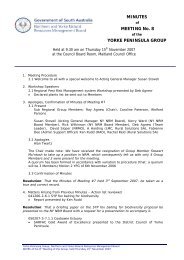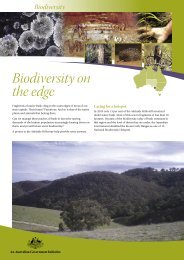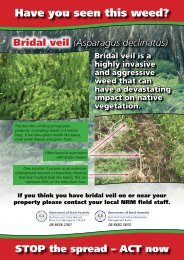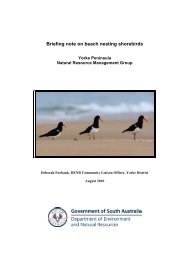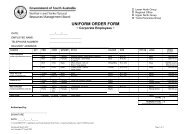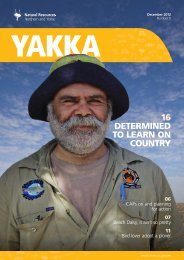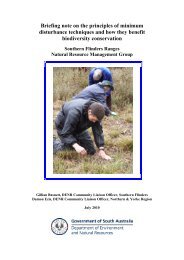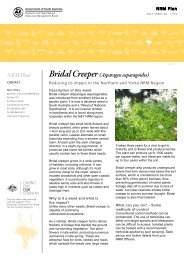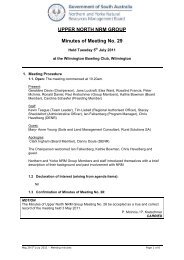Caring for country - Northern and Yorke Natural Resources ...
Caring for country - Northern and Yorke Natural Resources ...
Caring for country - Northern and Yorke Natural Resources ...
You also want an ePaper? Increase the reach of your titles
YUMPU automatically turns print PDFs into web optimized ePapers that Google loves.
4feature<br />
Good breeding<br />
The Mallee fowl mounds are one indication that living in Innes National Park is<br />
appealing to wildlife. Lance Campbell reports.<br />
For the shy, discreet but very Australian Mallee fowl,<br />
there’s no place quite like Innes National Park. Foxes<br />
<strong>and</strong> habitat clearance have pushed the gentle ground<br />
dwelling bird to the edge of extinction in many parts of<br />
the <strong>country</strong>, <strong>and</strong> in this State it is vulnerable.<br />
But in Innes, at the bottom southwest tip of <strong>Yorke</strong><br />
Peninsula, a monitoring program shows that there are<br />
3.8 Mallee fowls to each square kilometre – the highest<br />
concentration in South Australia.<br />
That’s the good news <strong>for</strong> the monitoring team led<br />
by Environment <strong>and</strong> <strong>Natural</strong> <strong>Resources</strong> Department<br />
threatened species officer Sharon Gillam. Breeding<br />
activity in Innes is stronger than in other Mallee fowl<br />
areas such as Murrayl<strong>and</strong>s, Sharon says, <strong>and</strong> will<br />
contribute to research into how to conserve the bird’s<br />
genetic diversity.<br />
And while the Mallee fowl is the main wildlife success<br />
story in Innes at the moment, other species are<br />
finding their way back to the park. Baby penguins are<br />
returning <strong>and</strong> there have been r<strong>and</strong>om sightings of<br />
bush stone curlews. Innes acting ranger Aaron Smith<br />
came across an echidna, the first confirmed sighting <strong>for</strong><br />
around 20 years.<br />
These positive outcomes <strong>for</strong> native birds <strong>and</strong> animals<br />
are largely the result of intense <strong>for</strong>tnightly fox baiting<br />
programs in <strong>and</strong> around Innes since the reintroduction<br />
of Tammar wallabies there six years ago. DENR baits<br />
within Innes <strong>and</strong> nearby Warrenben Conservation<br />
Park, while <strong>Northern</strong> <strong>and</strong> <strong>Yorke</strong> NRM Board operates<br />
simultaneously on private property in the area.<br />
Sharon reports no fox scats or tracks around the Mallee<br />
fowl mounds – <strong>and</strong> no rabbits either, <strong>for</strong> that matter.<br />
“You can almost say <strong>for</strong> certain that the fox baiting is<br />
benefiting the Mallee fowl,” she says, while Ken Rudd,<br />
NYNRM Board’s <strong>Yorke</strong> Peninsula animal <strong>and</strong> plant<br />
control officer, is more certain.<br />
“The Mallee fowl surveys are a key indicator that the<br />
baiting programs are working,” Ken says. “And it’s not<br />
only the Mallee fowl. It’s other birds, <strong>and</strong> lizards. The<br />
two programs complement each other. We’re both<br />
baiting <strong>for</strong> biodiversity spinoffs, <strong>and</strong> there has been an<br />
increase in lamb numbers.<br />
“We are keen to see the programs continue.”<br />
The Mallee fowl, or incubator bird or bush chook, is<br />
about the size of a small turkey <strong>and</strong> only flies when it<br />
has to. It belongs to a family of 22 species known as<br />
megapodes, or big feet birds, <strong>and</strong> eats seeds, flowers,<br />
fruit, tubers, fungi <strong>and</strong> invertebrates.<br />
Like the brush turkey, the Mallee fowl lays its eggs in<br />
mounds, made of s<strong>and</strong> <strong>and</strong> mallee leaf litter, which can<br />
be five metres around <strong>and</strong> a metre high.<br />
Most of the year is spent building <strong>and</strong> maintaining the<br />
mound. At Innes, breeding season is between October<br />
<strong>and</strong> February, the eggs are incubated by the warm<br />
s<strong>and</strong> decaying leaf matter at between 32C <strong>and</strong> 34C.<br />
The male Mallee fowl tends the eggs <strong>and</strong> checks the<br />
temperature by using his beak as a thermometer.<br />
The male adjusts the temperature by adding <strong>and</strong><br />
removing soil cover, or opening <strong>and</strong> closing the mound.<br />
He also digs a hole whenever the female is ready to lay<br />
another egg, <strong>and</strong> starts all over again. This can happen<br />
more than 30 times each breeding season.<br />
Once hatched, the chick fights its way through the<br />
debris <strong>and</strong> is immediately on its own, without parental<br />
care. It can run within an hour, <strong>and</strong> fly in a day. Even<br />
so, early mortality rates are high, but at Innes not as<br />
high as they once were.<br />
These Mallee fowl characteristics attract DENR<br />
community liaison officer Deb Furbank to the 3.5<br />
square kilometre survey grid of 47 mounds, out of<br />
around 60 known mounds at Innes. Mallee fowl are<br />
a “fascinating bird because of the way they incubate<br />
their eggs by building a giant compost heap,”<br />
Deb says.<br />
“The eggs can be a metre down in the mound when<br />
they hatch. In a harsh environment, with things going<br />
against them, Mallee fowl still survive.”<br />
Deb is one of a group of volunteers that works in Innes<br />
under Sharon Gillam, who coordinates Mallee fowl<br />
monitoring across the State. Most megapode birds<br />
are found in the tropics or sub-tropics, <strong>and</strong> while the<br />
Mallee fowl is adapted to the lower rainfall of southern<br />
Australia, Sharon says Innes is in “a very good rainfall<br />
position <strong>and</strong> has had good rain.”<br />
This promotes breeding activity.<br />
Each season about 10 of the mounds are active. In the<br />
most recent survey, the monitoring team saw Mallee<br />
fowl on or near five mounds, <strong>and</strong> another two in the<br />
scrub. It also was taken to a mound about a kilometre<br />
away from the grid, <strong>and</strong> saw another bird in the scrub<br />
near Inneston.<br />
An infra red camera was set up, <strong>and</strong> monitored<br />
nocturnal Mallee fowl activity from November until<br />
February. “We got some great data on Mallee fowl<br />
behaviour from that camera,” Aaron says. “We saw<br />
them opening the mound, <strong>and</strong> bringing material to<br />
keep it warm.”<br />
As well as trends in Mallee fowl breeding activity, the<br />
team also keeps an eye out <strong>for</strong> other factors, such<br />
as food availability, predators <strong>and</strong> human interference.<br />
Sharon is pleased to report that the latter is not<br />
an issue.<br />
A Mallee fowl nest in Innes National Park is inspected by Ken Rudd<br />
(right), NYNRM Board’s <strong>Yorke</strong> Peninsula authorised officer, <strong>and</strong><br />
Deb Furbank, DENR’s <strong>Yorke</strong> Peninsula community liaison officer.<br />
Photo Hannah Short<br />
The team saw an owlet nightjar <strong>and</strong> emu, <strong>and</strong> heard<br />
butcher birds, grey currawongs <strong>and</strong> ravens. But there<br />
were no foxes to kill the Mallee fowl, nor rabbits, deer<br />
or goats to impinge on their food sources.<br />
In SA, the Innes grid has had the highest breeding<br />
activity per squared kilometre consistently over the past<br />
four seasons, Sharon reported to NYNRM Board. For all<br />
the kind conditions <strong>for</strong> Mallee fowl at the Bottom End,<br />
she told Yakka, southern <strong>Yorke</strong> Peninsula was “a bit of<br />
a bottleneck.”<br />
She would like to see adjacent patches of mallee<br />
connected, so the birds can disperse further.<br />
Deb Furbank says being on the Mallee fowl team<br />
has been “inspiring, working in an environment<br />
where things are improving, instead of seeing them<br />
downgraded. Nationwide the Mallee fowl figures are<br />
dropping, but in Innes they are stable, even increasing.<br />
“It’s nice to be involved in a positive outcome.”<br />
Left: Australian Mallee fowl.<br />
Photo: Graeme Chapman<br />
<strong>Northern</strong> <strong>and</strong> <strong>Yorke</strong> <strong>Natural</strong> Resource Management Board 9




